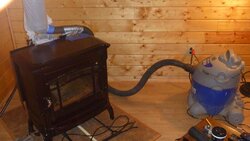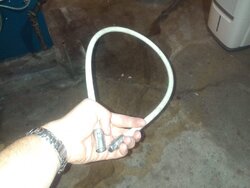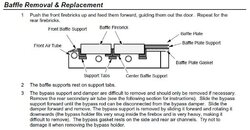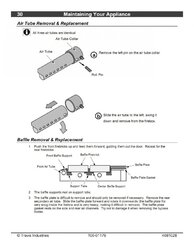I had a lot of trouble with mine. It may have had something to do with my flue being 7x11 and thus the rod being able to swim around too much. I pushed the thing up one rod at a time. When I turned the drill on, it set up such a twist in the rod that you could not use it. The thing was pouncing off the flue walls with that hard ball ricocheting off the flue sides so hard that I got concerned with actually busting one of the flue tiles. My chimney is 25 ft tall and I sent it through the clean out door. It had to bend 90* but I tried it twice and found it easier just to climb the roof and sweep the chimney with the brush as I always had.
Sooteater
- Thread starter neumsky
- Start date
-
Active since 1995, Hearth.com is THE place on the internet for free information and advice about wood stoves, pellet stoves and other energy saving equipment.
We strive to provide opinions, articles, discussions and history related to Hearth Products and in a more general sense, energy issues.
We promote the EFFICIENT, RESPONSIBLE, CLEAN and SAFE use of all fuels, whether renewable or fossil.
You are using an out of date browser. It may not display this or other websites correctly.
You should upgrade or use an alternative browser.
You should upgrade or use an alternative browser.
- Status
- Not open for further replies.
jharkin
Minister of Fire
I have a fairly tall chimney, so I was looking at ordering extra rods, when I realized it was about the same price to just order two sooteaters. Now, I have the extra rods I need, plus a spare sooteater head.
Good choice. You have even more chimneys than me so you will find the second head useful for different sized flues.
jharkin
Minister of Fire
Perhaps you can bend a rod in a "u" shape, but I had trouble getting one to bend 90 degrees. They were much stiffer than I expected, but they worked great. I'm going to revive my gym membership on Monday...
In the directions for the Sooteater they specifically show a diagram with an X through it indicating you should not bend a rod 90 degrees as it will damage the product.
I wonder if they changed the material the rods are made of?? Mine are a soft whit non-rigid plastic. Feels like a vinyl type material. I just went down to the basement and tried again, and I effortlessly bent one in a loop. I think a child could bend these in half. My instructions dont have any warnings about 90s and show diagrams of cleaning a stovepipe by running the rod in the firebox door and turning 90 to go straight up the flue. Also photos of users bending them like so.
C
charly
Guest
My set which are about 4 years old came with 3 white rods as you described and the rest were thicker black rods.. Both of my stove pipes don't require the 90 bend to clean.. Only my gray water drain had the 90 which still allowed the rods to slip around it easily..I wonder if they changed the material the rods are made of?? Mine are a soft whit non-rigid plastic. Feels like a vinyl type material. I just went down to the basement and tried again, and I effortlessly bent one in a loop. I think a child could bend these in half. My instructions dont have any warnings about 90s and show diagrams of cleaning a stovepipe by running the rod in the firebox door and turning 90 to go straight up the flue. Also photos of users bending them like so.
jharkin
Minister of Fire
DanCorcoran
Minister of Fire
DanCorcoran
Minister of Fire
jharkin
Minister of Fire
Thanks. I tried to take the double-walled pipe down today, but wasn't able to do it. In the manual it looks like I might have to remove one of the air tubes to get at the rear baffle bricks -- though the description talks about a bypass damper, which the 1750 doesn't have, so maybe this manual is for a different generation.That's convinced me. Ordering one today.
1750, gently remove the rear baffle bricks and plate. Then I think you should be able to do a bottom up cleaning.
It's too bad a bottom-up cleaning isn't more directly feasible with most of these stoves. I bet it would get done more reliably if people didn't have to go up on the roof!
Thanks again.
Thanks. I don't know the territory well enough to understand what I'm looking at.I think you can leave the tube in and just remove the firebricks and the rear baffle plate. Look at page 30 in the 1750's manual.
View attachment 108889
PS: yes this seems to be copied from the Endeavor which has a bypass.
If I can get the bricks up and out, does the baffle just lift off the support bracket/gasket? In the illustration it looks like the support bracket and baffle are the same thing.
Thanks again.
HDRock
Minister of Fire
I just took the baffle bricks out of the 1750 I bought today,. front bricks, tip the back up, slide em back, tip front down slide em out, back bricks , slide middle support to front ,tip front of bricks down take em out, don't have to take out tubes, It is tricky though.Thanks. I tried to take the double-walled pipe down today, but wasn't able to do it. In the manual it looks like I might have to remove one of the air tubes to get at the rear baffle bricks -- though the description talks about a bypass damper, which the 1750 doesn't have, so maybe this manual is for a different generation.
It's too bad a bottom-up cleaning isn't more directly feasible with most of these stoves. I bet it would get done more reliably if people didn't have to go up on the roof!
Thanks again.
Thanks! Would you be able to get access to the chimney when you do this? (Did you take the baffle plate out, as well?)I just took the baffle bricks out of the 1750 I bought today,. front bricks, tip the back up, slide em back, tip front down slide em out, back bricks , slide middle support to front ,tip front of bricks down take em out, don't have to take out tubes, It is tricky though.
Thanks again.
HDRock
Minister of Fire
Yes , once U slide the center support forward , you can see and U can go behind, or in front the back tube, in front of the rear Baffle Plate.Thanks! Would you be able to get access to the chimney when you do this? (Did you take the baffle plate out, as well?)
Thanks again.
Getting dark out but pic U see Baffle Plate from top and a glimpse of the rear tube
(Did you take the baffle plate out, as well?) No
Center support is one piece ,looks like 2 in manual
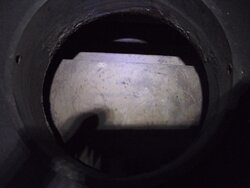
Nick Mystic
Minister of Fire
I just ordered my Sooteater a couple of months ago and it has the black rods like the ones Dan described in his post. I didn't try bending one like Jeremy's photo, but I'd be surprised if I could without damaging it. So, maybe there is a difference between the white and black rods. I only had to use the six rods that come in one kit to do my flue and I didn't experience any problems with the rods bouncing around, but then too I was going straight down a 6" SS liner and not a rectangular clay tile. Also, I cut my lines a bit longer than the directions instructed. They say to cut a quarter inch longer than your inside diameter and I added another half inch, making them closer to 7". I figured a snugger fit might do a better job cleaning.
Wow, you have done me a big favor taking that picture. I seriously appreciate you making this effort.Yes , once U slide the center support forward , you can see and U can go behind, or in front the back tube, in front of the rear Baffle Plate.
Getting dark out but pic U see Baffle Plate from top and a glimpse of the rear tube
(Did you take the baffle plate out, as well?) No
Center support is one piece ,looks like 2 in manual
View attachment 108913
I'll have to take a look at this next weekend and have a run at it.
Do you think the opening is large enough to allow a standard chimney brush to run up into it for cleaning, or just something like this more flexible Sooteater?
Thanks again for your help.
HDRock
Minister of Fire
The standard chimney brush rods probably wouldn't work , but don't go by me, I wasn't thinking about that at the time , I'm not sure if the back support comes out or not , I will be taking out tubes and all ,and cleaning it all up, before I grab it and toss it in the houseDo you think the opening is large enough to allow a standard chimney brush to run up into it for cleaning, or just something like this more flexible Sooteater?

No prob ! I'll get some better ones for yaWow, you have done me a big favor taking that picture. I seriously appreciate you making this effort.
See if just the back baffle comes out, not the baffle support. That should be all you need for cleaning.
HDRock
Minister of Fire
HDRock
Minister of Fire
Yes it does, I did lift it slightly, BUTDoes the back baffle plate just lift out once the back baffle brick is removed?
3: The baffle plate is difficult to remove and should only be removed if necessary. Remove the rear secondary air tube. Slide the baffle plate forward and rotate it downwards (the baffle plate fits very snug inside the firebox and is very heavy, making it difficult to remove). The baffle plate gasket rests on the side and rear air channels
I didn't want to pull it cuz as U see , there is a gasket under it, don't want to get a bunch of crude on the gasket
HDRock
Minister of Fire
That's the way it goes, the old rods just get more flexibleI just ordered my Sooteater a couple of months ago and it has the black rods like the ones Dan described in his post. I didn't try bending one like Jeremy's photo, but I'd be surprised if I could without damaging it. So, maybe there is a difference between the white and black rods. I only had to use the six rods that come in one kit to do my flue and I didn't experience any problems with the rods bouncing around, but then too I was going straight down a 6" SS liner and not a rectangular clay tile. Also, I cut my lines a bit longer than the directions instructed. They say to cut a quarter inch longer than your inside diameter and I added another half inch, making them closer to 7". I figured a snugger fit might do a better job cleaning.



DanCorcoran
Minister of Fire
That's the way it goes, the old rods just get more flexible

My condolences on your loss...

C
charly
Guest
I'm thinking they might have stopped producing the white rods and moved onto just the thicker black rods to help take the wobble out of the rods while spinning..I just ordered my Sooteater a couple of months ago and it has the black rods like the ones Dan described in his post. I didn't try bending one like Jeremy's photo, but I'd be surprised if I could without damaging it. So, maybe there is a difference between the white and black rods. I only had to use the six rods that come in one kit to do my flue and I didn't experience any problems with the rods bouncing around, but then too I was going straight down a 6" SS liner and not a rectangular clay tile. Also, I cut my lines a bit longer than the directions instructed. They say to cut a quarter inch longer than your inside diameter and I added another half inch, making them closer to 7". I figured a snugger fit might do a better job cleaning.
clemsonfor
Minister of Fire
I have basically the same setup, my chimney is like 23ish though. And my tiles are that size as well, they flopped around but they also beat all the creosote off the walls, the rods wobbled but no big deal here, I mean its clean enough for a chimneyI had a lot of trouble with mine. It may have had something to do with my flue being 7x11 and thus the rod being able to swim around too much. I pushed the thing up one rod at a time. When I turned the drill on, it set up such a twist in the rod that you could not use it. The thing was pouncing off the flue walls with that hard ball ricocheting off the flue sides so hard that I got concerned with actually busting one of the flue tiles. My chimney is 25 ft tall and I sent it through the clean out door. It had to bend 90* but I tried it twice and found it easier just to climb the roof and sweep the chimney with the brush as I always had.

Mine are a black plastic like others say. I ordered mine from amazon thorough some 3rd party hardware or stove sore or something?? I got it begenning of this summer.I wonder if they changed the material the rods are made of?? Mine are a soft whit non-rigid plastic. Feels like a vinyl type material. I just went down to the basement and tried again, and I effortlessly bent one in a loop. I think a child could bend these in half. My instructions dont have any warnings about 90s and show diagrams of cleaning a stovepipe by running the rod in the firebox door and turning 90 to go straight up the flue. Also photos of users bending them like so.
- Status
- Not open for further replies.
Similar threads
- Replies
- 10
- Views
- 1K
- Replies
- 38
- Views
- 4K
- Locked
- Replies
- 72
- Views
- 5K


